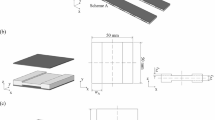Abstract
As a main structure of the stratosphere airship, the typical envelope material is flexible fabric membrane composite. The high-low alternated temperature of the stratosphere has a great influence on the mechanical property of the envelope material. Thermoelasticity of the envelope material is first investigated based on a micromechanical model. The modulus and coefficient of thermal expansion of the material are simulated respectively and compared with the measured results. It can be concluded that the material owns the similar nonlinearity character both in warp and weft directions and the modulus in both directions increase to a steady-state value gradually from a relatively small value. The coefficients of thermal expansion of the material in two directions in the plane are quite small compared with the out-plane direction because of the constraint effect between yarns and matrix. The thermal distribution and the deformation of the envelope material in different temperatures are carried out at last. It is expected that the results are significative for the engineering design.












Similar content being viewed by others
References
Yousef, M.I., Stylios, G.K.: Legacy of the Zeppelins: defining fabrics as engineering materials. J. Text. Inst. 106(5), 480–489 (2014). doi:10.1080/00405000.2014.926606
Ambroziak, A.: Analysis of non-linear elastic material properties of PVC-coated Panama fabric. Task Q. 9(2), 167–178 (2005)
Argyris, J., Doltsinis, I.S.: Constitutive modelling and computation of non-linear viscoelastic solids. Part I: Rheological models and numerical integration techniques. Comput. Methods Appl. Mech. Eng. 88(2), 135–163 (1991)
Kłosowski, P., Zagubień, A., Woznica, K.: Investigation on rheological properties of technical fabric “Panama”. Arch. Appl. Mech. 73(9–10), 661–681 (2004)
Chen, S., Ding, X., Fangueiro, R., Yi, H., Ni, J.: Tensile behavior of PVC-coated woven membrane materials under uni- and bi-axial loads. J. Appl. Polym. Sci. 107(3), 2038–2044 (2008). doi:10.1002/app.27303
Yingying, Z., Xiaoguang, S., Qilin, Z., Henglin, L.: Fracture failure analysis and strength criterion for PTFE-coated woven fabrics. J. Compos. Mater. 49(12), 1409–1421 (2014). doi:10.1177/0021998314534706
Ambroziak, A., Kłosowski, P.: Mechanical properties for preliminary design of structures made from PVC coated fabric. Constr. Build. Mater. 50, 74–81 (2014). doi:10.1016/j.conbuildmat.2013.08.060
Ou, Y., Zhu, D.: Tensile behavior of glass fiber reinforced composite at different strain rates and temperatures. Constr. Build. Mater. 96, 648–656 (2015). doi:10.1016/j.conbuildmat.2015.08.044
Ambroziak, A., Kosowski, P.: Influence of thermal effects on mechanical properties of PVDF-coated fabric. J. Reinf. Plast. Compos. 33(7), 663–673 (2013). doi:10.1177/0731684413512705
Tsai, S.W.: Strength & life of composites. Stanford University, (2008)
Deng, X., Chawla, N.: Three-dimensional (3D) modeling of the thermoelastic behavior of woven glass fiber-reinforced resin matrix composites. J. Mater. Sci. 43(19), 6468–6472 (2008). doi:10.1007/s10853-008-2982-6
Alzina, A., Toussaint, E., Béakou, A.: Multiscale modeling of the thermoelastic behavior of braided fabric composites for cryogenic structures. Int. J. Solids Struct. 44(21), 6842–6859 (2007). doi:10.1016/j.ijsolstr.2007.03.013
Li, J., Kwok, K., Pellegrino, S.: Thermoviscoelastic models for polyethylene thin films. Mech. Time-Dependent Mater. 20(1), 13–43 (2015). doi:10.1007/s11043-015-9282-8
Roh, J.-H., Lee, H.-G., Lee, I.: Thermoelastic behaviors of fabric membrane structures. Adv. Compos. Mater. 17(4), 319–332 (2008). doi:10.1163/156855108x385285
Kang, W., Suh, Y., Woo, K., Lee, I.: Mechanical property characterization of film-fabric laminate for stratospheric airship envelope. Compos. Struct. 75(1–4), 151–155 (2006). doi:10.1016/j.compstruct.2006.04.060
Rand, J.L., Wakefield, D.: Studies of thin film nonlinear viscoelasticity for superpressure balloons. Adv. Space Res. 45(1), 56–60 (2010). doi:10.1016/j.asr.2009.09.004
Mustafa, G., Suleman, A., Crawford, C.: Probabilistic micromechanical analysis of composite material stiffness properties for a wind turbine blade. Compos. Struct. 131, 905–916 (2015). doi:10.1016/j.compstruct.2015.06.070
Upadhyaya, P., Upadhyay, C.S.: A three-dimensional micromechanical model to predict the viscoelastic behavior of woven composites. Compos. Struct. 93(11), 2733–2739 (2011). doi:10.1016/j.compstruct.2011.05.031
Kim, M., Song, J.I.: Geometry effect on mechanical properties of woven fabric composites. J. Cent. South Univ. Technol. 18(6), 1985–1993 (2011). doi:10.1007/s11771-011-0932-y
Beers, D., Ramirez, J.: Vectran high-performance fibre. J. Text. Inst. 81(4), 561–574 (1990)
Young, L.: CTE curve fitting data. NASA balloon program office report (2010).
Chawla, K.K.: Metal matrix composites. Wiley Online Library, (2006).
Schapery, R.A.: Thermal expansion coefficients of composite materials based on energy principles. J. Compos. Mater. 2(3), 380–404 (1968)
Author information
Authors and Affiliations
Corresponding author
Rights and permissions
About this article
Cite this article
Meng, J., Cao, S., Qu, Z. et al. Thermoelasticity of a Fabric Membrane Composite for the Stratospheric Airship Envelope Based on Multiscale Models. Appl Compos Mater 24, 209–220 (2017). https://doi.org/10.1007/s10443-016-9522-3
Received:
Accepted:
Published:
Issue Date:
DOI: https://doi.org/10.1007/s10443-016-9522-3




